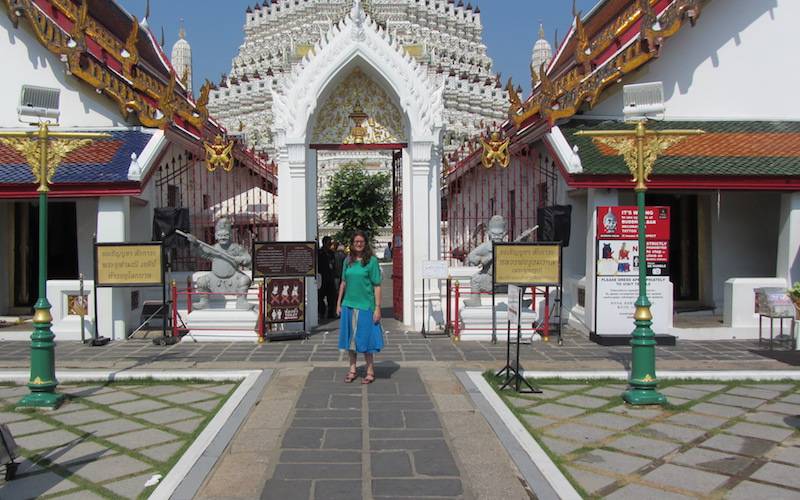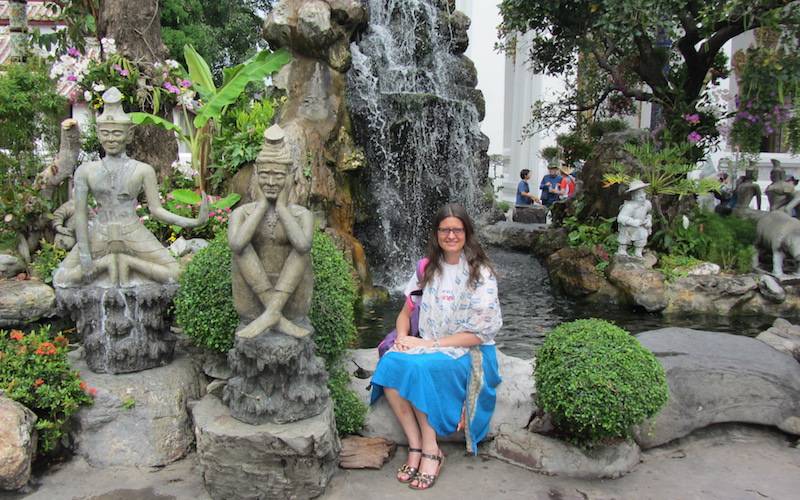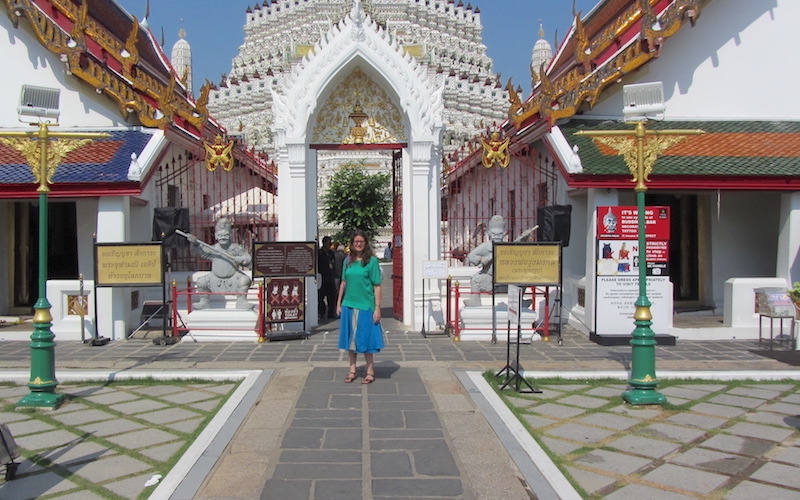I’ve spent a whole month in Thailand, and lots of fellow travellers ask me about the Thailand Temple Dress Code. When visiting temples in Thailand, it’s important to dress modestly and respectfully as a sign of reverence for the religious and cultural practices of the country. Temples are considered sacred places, and adhering to the appropriate dress code shows your respect for local customs. So whether you are exploring the ancient ruins of Sukhothai historical park or checking out the temples of Bangkok, there are a few rules that you should follow.
Let’s take a look at some guidelines for dressing appropriately when visiting temples in Thailand…But first, can non-Buddhists enter Thai temples?
Can non-Buddhists visit Thailand Temples?
Yes, you will be pleased to know that even if you are not a Buddhist, you will still be very welcome to visit Buddhist temples. Some have a charge for tourists to visit, but many are free and very inclusive. In the free temples, it is a nice gesture to make a small donation, which will go towards the upkeep of the temple and those in need in the local Buddhist community.
Here’s a little story from my travels to show you how welcoming the Thai Buddhists can be….
When I arrived in Chiang Rai, I hired a bike to explore all of the Chiang Rai temples for my blog. I headed into Wat Klang WIang (informally known as the fire temples) to have a look around the grounds and pay my respects to Buddha in the main vihara. When I came out, I found that my bike basket had been filled with snacks and goodies by a Buddhist monk while I was inside the temple! I found drinks, crisps and sweets for my journey!

What is the best time of year to visit the Temples of Thailand
Thailand has two main seasons – dry (hot) and humid (rainy season). You definitely don’t want to be there in the Monsoon rains, so visit Thailand between November and April. I went in early April, which was a good time to go, but I was shocked by the intensity of Songkran! Songkran is Thai new year and everyone just throws water over you – foreigners are a hot target! Although it was fun, I found Songkran in Chiang Mai to be a bit intense after 5 days! December and January are great times to visit the temples of Thailand. Remember to check the Buddhist calendar to see what celebrations you might see.
Some Guidelines for Visiting Thai temples
It’s important to remember that you are visiting a place of worship – a very peaceful and sacred place for Thai Buddhists. Therefore, you should dress conservatively and behave appropriately. Here are a few guidelines on what is and what is not acceptable in Thai temples…
- Dress conservatively – that means not too much flesh on display. Men and women should both avoid short shorts. Men and women should both avoid vest tops and ladies should cover their arms and shoulders. Don’t display clevage!
- Remove your Footwear: You should remove your shoes before entering temple buildings. It’s a good idea to wear slip-on shoes or sandals for easy removal.
- Never point your feet towards Buddha – it is very disrespectful.
- Avoid shouting and loud laughing inside Thai Buddhist temples – as it is a place of worship you should remain as quiet as possible.
- Don’t cross in front of someone during prayer – It is rude and disrespectiful and would interrupt their prayers.
- Check before Photographs – Most temples allow you to take photographs of the Buddha and the inside, but it’s always best to ask first.
- Avoid Buddha selfies and photographing worshippers – Don’t take photos of people worshipping during prayer and avoid taking selfies with Buddha.
- Buddha is for worship and not for decoration – this means that you should not be wearing T-shirts with Buddha on to visit Thai temples, and anyone with a Buddha tattoo should make the effort to cover it so as not to cause offence.
- Don’t bring a big backpack – Big backpacks are not suitable for visiting Thai temples, and they could even damage it if you were to swing round and catch it on one of the statues by mistake. Leave it at the hostel or left luggage where it belongs!
- Don’t touch children (or anyone) on the head – the head is the most sacred place to Buddhists and although in some countries it is a sign of affection, it is disrespecful to touch someone’s head in Thailand.
What to wear in Thailand temples
You will need to consider your own personal comfort in the heat of Thailand, as well as the Thailand temple dress code, so dress conservatively, but comfortably. The great news is that T-shirts, long skirts and cotton pants are VERY cheap in Thailand. So don’t worry about taking everything that you need – shop when you get there!

Thailand Temples Dress Code for Both Men and Women:
- Cover Shoulders and Knees: Wear clothing that covers your shoulders and knees. Sleeveless tops, tank tops, and short skirts or shorts should be avoided. Elephant trousers are a popular thing to buy in Thailand – they are cheap and suitable for temple visits.
- Loose-Fitting Clothing: Choose loose-fitting and comfortable clothing. Tight or revealing clothing is not suitable for temple visits, so leave the spaghetti straps at home! Linen tops, full T shirts and blouses with sleeves are ideal.
- Remove Hats and Shoes: Remove your hat and shoes before entering temple buildings or sacred areas. Some temples might have designated areas for leaving your shoes. Comfortable slip on flats or sandals are a good idea to take.
Thailand Temples Dress Code For Women:
- Avoid Low-Cut Tops: Avoid wearing tops with low necklines or showing cleavage. No spaghetti straps, and certainly no bikinis!
- Long Skirts or Pants: Opt for long skirts or cotton pants instead of short skirts. If you’re wearing a skirt, make sure it falls below the knee.
- Scarf or Shawl: Carrying a scarf or shawl that you can drape over your shoulders when needed can be a useful accessory. I used mine a lot in Thailand and it was also useful for keeping me warmer when it started to get chillier at night.

Thailand Temple Dress Code For Men:
- Long Pants: Wear long pants or trousers. Avoid shorts, especially when entering temple buildings.
- Shirts with Sleeves: Choose shirts or T-shirts with sleeves. Sleeveless shirts are not appropriate for temple visits.
- Sandals or flip flops that can easily slip on and off.

Additional things to note about Visiting Thai Temples
Note that the dress code also applies to royal palaces (such as the Grand Palace in Bangkok) and other historical sites, not just temples.

It’s important to note that while these guidelines are generally applicable, some temples may have specific rules or variations in their dress code. To ensure you’re appropriately dressed, you can also observe what the locals are wearing or inquire with the temple staff if you’re unsure. By dressing respectfully, you’ll be able to fully appreciate the cultural and spiritual experience of visiting temples in Thailand.
The Best Temples to Visit in Thailand
So, now you’re all set with what to wear when visiting the Thai temples, I guess that you want to know the best temples to visit in Thailand? Here are my top choices….
- Bangkok – Wat Arun, Wat Pho (reclining Buddha) and Grand Palace (contains Wat Phra Keaw temple of the Emerald Buddha).
- Chiang Mai – Wat Chiang Man, Wat Chedi Luang, Wat Doi Suthep.
- Chiang Rai – Wat Rong Suea Ten (blue temple), Wat Rong Khun (white temple) and Bandaam Museum (black house).
- Sukhothai – Wat Mahatat, Wat Si Sawai, Wat Sa Si, Wat Sorasak, Wat Tra Phang Ngoen, Wat Si Chum.
- Ayutthaya – Wat Mahatat (with Buddha head in the Bodhi tree), Wat Chaiwatthanaram and Wat Cha Mongkhon.
- Lopburi – Phra Prang Yam Sot (Monkey temple)
- Pattaya – Sanctuary of Truth
- Phuket – Big Buddha temple and Chalong Temple.
Thanks for reading!
I hope that you found this article on the Thailand Temple Dress Code helpful. Thailand is such an amazing country to explore, and I hope that you have a wonderful time there. You. might also like to read:
- What to wear in Thailand
- Visiting the Lopburi Monkey temple Thailand.
- Solo travel Thailand
- Is Bangkok worth visiting?

